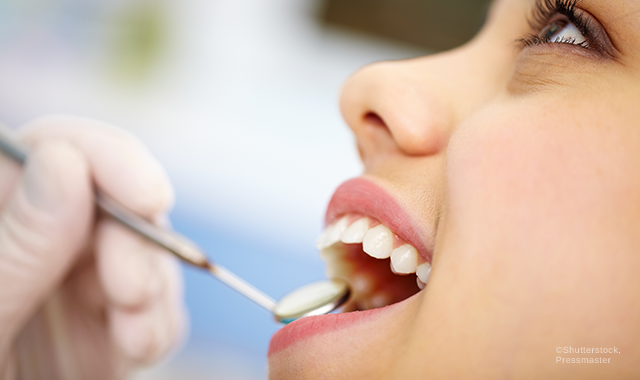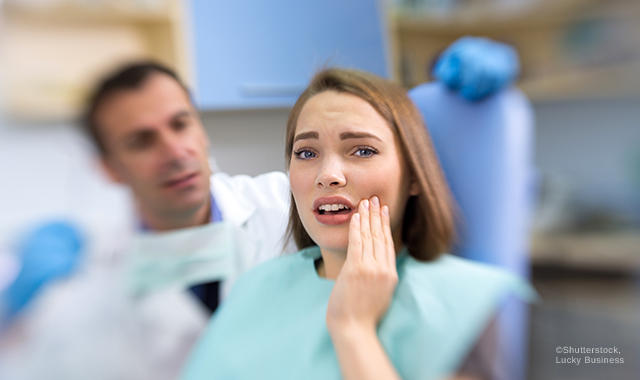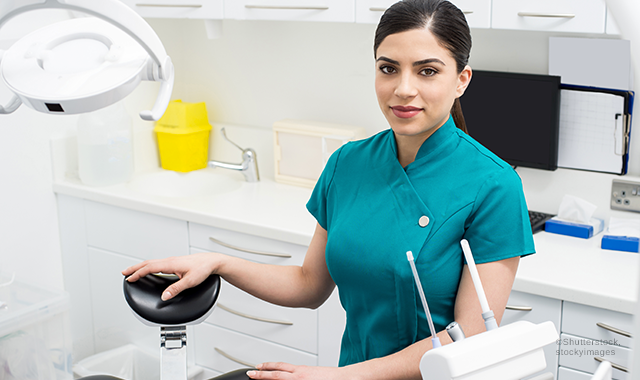5 fascinating questions dental hygienists asked Kara RDH in August
As the founder of dentalhygieneanswers.com, Kara Vavrosky has heard a lot of questions this month. Here is the latest installment of some of the ones that stuck out the most to her.
As a well-known and accomplished dental hygienist, Kara Vavrosky often gets asked for advice.

She runs the popular Facebook page Dental Hygiene with Kara RDH and is also the founder of dentalhygieneanswers.com, a question-and-answer platform for dental hygienists.
Here, Vavrosky shares five more interesting questions she's been asked recently, along with her answers.
Continue to the next page to view our slideshow of these questions and answers.


Fluoride varnish and tree nut allergies
Is all fluoride varnish contraindicated for patients with tree nut allergies?
The short answer is not necessarily. Not all fluoride varnishes contain tree nut oil and/or rosin (colophony). It’s also worth mentioning that a tree nut allergy doesn’t necessarily mean a patient is allergic to rosin. I mention this because, for instance, Preventech (Vella varnish) extracts rosin from pine tree stumps (not live trees) so it doesn’t contain sap. Their website states, “…this reduces any adverse reaction to rosin products due to tree nut allergies.” Dentsply Nupro’s website states the same.
More from Kara RDH: 5 interesting questions dental hygienists asked Kara RDH in March
Otherwise, varnishes such as Elevate Fluorimax, Medicom Duraflor Halo, Young D-Lish, among others don’t contain tree nut derivatives; this is stated on their websites. I would suggest checking out the website or calling the manufacturer of the varnish you use to know for sure. Your best bet is to always be aware of the ingredients in the products you use!



Patient with active perio only wants to whiten teeth
I have had patients lately who have active perio, but are only concerned with whitening their teeth. I don’t know what to say to these patients or how to explain that whitening is the least of their concerns. How would you go about dealing with this situation? It’s frustrating!
Sometimes patients’ priorities aren’t on health, but cosmetics alone, and it can be frustrating. While it’s easy to discount their priorities, instead you can use it to your advantage. What I mean by that is use whitening as a goal the patient can achieve once they have achieved health – use getting the gingiva healthy as a stepping stone to their goal of whiter teeth.
First, I would educate the patient on their condition, how it relates to overall health, and the link to systemic diseases. Here is an example of what you can say to your patient:
“Bacteria accumulates under your gums. If it’s not removed properly, the longer it sits, the stronger it gets. This leads to bleeding gums and inflammation, otherwise known as gingivitis, and is reversible with good homecare habits. However, if the bacteria sit long enough it can lead to the breakdown of your gums and the bones that hold your teeth in (here, you can explain probe depths). This is called periodontitis and it’s not reversible, but can be halted and maintained with professional care and with brushing twice per day and cleaning in between the teeth with –(insert whichever method would be best for the patient here). This same bacteria causing inflammation and disease in your mouth has been linked (by research) to many bodily diseases such as heart disease, stroke, cancer, low birth weight/pre-term babies, etc. This is why it’s so important to have a healthy mouth.”
More from Kara RDH: 5 interesting questions dental hygienists asked Kara RDH in November
At this point don’t be afraid to use an intraoral camera or mirror to show the patient supragingival calculus, recession, inflammation, etc. in their mouth. Show them their radiographs of bone loss. Use visual aids of healthy to severe perio pictures (it’s a good idea to keep images saved on your computer in your operatory to show patients).
This is when you use your patient’s health as a stepping stone towards whitening. “Before we whiten your teeth, they need to have a strong and healthy foundation. You wouldn’t remodel a kitchen, paint a house or put a new roof on a house if the foundation was crumbling. The same thinking applies to your gums and teeth. We want your gums healthy, as they are the foundation of your teeth, before focusing on cosmetics (or looks). Teeth need a strong foundation too. Once, your gums are healthy, whitening is then an option. So let’s get your foundation healthy so we can get you whitened!”
It is our job as hygienists to educate on the importance of health first and helping patients understand why it’s important. It does take time and we can feel like a broken record, but we would be spinning our wheels and doing our patients a disservice if we didn’t do it. It also takes time to get your spiel down, but once you do, you can tweak it depending on the patient’s level of understanding and what motivates them as an individual. Practice your explanation with a few non-dental people like your significant other, friend, or family member, and let them give you feedback on what does and doesn’t make sense. This will give you a more accurate sense of if what you are saying makes an impact and would make sense to a patient.
While it can be frustrating, understand that we know a lot as dental professionals. It’s easy to take that for granted because it’s not all common knowledge, even though it seems so to us. Be compassionate to the patient’s priorities, but be prepared to take the extra time to explain why your treatment plan is important to health. Scalers up, you got this!


ADVERTISEMENT



Patients that only want topical for SRPs
I am a recent grad and noticing that some of the patients in the office I work in only want topical for when I notice they require an SRP. This is starting to annoy me for several reasons:
1. I feel confident when I give anesthesia but feel like I am going to forget how to give it if the patients keep saying that the topical is fine.
2. I feel like I am hurting the patient when going subgingival and know that they did not receive local anesthesia so I don’t go as deep or with as much lateral pressure as I should be.
3. Blood is everywhere because they didn’t let me give them the Lido with epi.
4. They claim they are comfortable with just topical!
I don’t know what to do, do you think the patients think because I’m young and newer that I wouldn’t know how to give anesthesia properly or because they just don’t want an injection. Am I being paranoid? Any tips for me on this subject are greatly appreciated!
Being a recent grad can be trying at times! I don’t think the majority of patients aren’t wanting injections because they think you are young and “less experienced.” I think most people don’t like shots, period. Regardless of whether topical or local is used, you need to be able to scale without hesitation in a way that is effective. However, if the patient requested topical and isn’t tolerating treatment, then it’s time to do injections. It may help if your doctor comes in and justifies the need for local anesthesia to the patient until you are comfortable being firm with patients. This also applies if the bleeding is severe. You must do what is needed to treat the patient thoroughly.
More from Kara RDH: 5 fascinating questions dental hygienists asked Kara RDH in January
Backing up a bit here, when I explain the need for SRPs to a patient, I tell them that the treatment requires me to get them numb. I say that if they are comfortable, I can do a better job. I explain that if I leave a piece of calculus and their tissue heals around it, they can get an abscess – so I must get everything out from under their gums. I set them up expecting injections. Now, some hygienists have great success with using only Oraqix or Cetacaine, but like you, I find patients are still tender and the bleeding is out of control, so I prefer local anesthesia. Point here, is if you need to do injections, you need to get the patients on board and be a bit firm.
Regarding forgetting how to give injections, I totally get your concern here. Just remember that there are ways to keep your skills sharp like YouTube videos and other videos and articles online. You can even watch your doctor give injections once in a while to keep a visual in your head. Of course there is no real substitution for experience. The more you do, the better you’ll get and the less you’ll worry about it.
If it’s any consolation, I have had patients ask me if I was old enough to be cleaning their teeth. Well, being in my mid-thirties, I’d think so! If patients think you look young, take it as a compliment and own it. Many patients are fearful so they project that fear onto you and use you as an excuse. Sometimes just realizing that helps to not take it personally, at least for me anyway. I hope it helps you too!



PSA block complication
I recently administered the right PSA on a patient. Seconds after, my patient expressed that it hurt more than when I had numbed the left side a week prior and she kept expressing that her cheek felt puffy and hard. I attempted to massage the anesthetic into the nerve but the patient continued to tell me that it felt strange. I retrieved the doctor in my office and she continued to massage the patient’s cheek. Long story short, I performed SRP’s but the patient was still feeling “puffy” and strange. What could have happened? There was no trace of a hematoma, no observant facial paralysis. What could I have numbed?
It sounds like you inadvertently nicked or punctured a blood vessel. This doesn’t always lead to a hematoma with a visually-apparent “bruise,” like if you perforated an artery. A bruise doesn’t always appear either because of the density of the tissue around the certain blood vessel. The best treatment here would have been for the patient to ice the area immediately and then to continue icing for the next 24 hours or so at 20-minute intervals every couple hours. Heat should not be applied for the first 24 because it is a vasodilator. The patient’s symptoms should heal in 10-14 days. If it doesn’t get better in that time frame, they should contact the office.
More from Kara RDH: 5 fascinating questions hygienists asked Kara RDH in June
There is a risk of secondary infection, so the patient should be aware and possibly monitored for that. I do want to mention that the PSA block is a high-risk injection for complications due to the highly vascular area you are injecting into, and sometimes this just happens. All patients are different anatomically and we don’t have X-ray vision (wouldn’t that be awesome, though?!), so we have to do our best using the training we have. My point is, don’t feel like you were necessarily wrong or having poor technique with your injection!



Frustrated and don’t know where to start
I’m a recent graduate and just started a mostly (three to four days a week) full-time position with an office. I’m a little concerned with starting out on the wrong foot concerning patient care and what I was taught in school and feeling like crap at the end of the day. When I accepted this position I was thrilled to have found my dream job so soon. The dentist’s main focus is patient education about periodontal disease. There were many promises about opportunities and room for growth.
Here is the downside:
1. My office does FMD and adult prophys with three-to-four month re-evals on new patients really needing SRP. The way my office does it, is upon comprehensive evaluation, if there are 4+ mm pockets in either quad both facially and lingually, the recommendation is SRP. Which is fine. But all of these patients get FMD or an adult prophy (whichever insurance with cover) before that SRP. In school I was taught that FMD can cause the pockets and tissue to heal basically trapping bacteria and toxins increasing the opportunity for abscess.
2. The hygienists see one patient per hour which is fine, but if I have a patient with little to no build-up, extremely good homecare, their cleaning is not going to take a full hour if all I am doing is an adult prophy and exam. The office manager has said I am getting done too quickly (45 minutes) and need to spend the entire hour cleaning. My thought process is do the cleaning and OHI, exam, then schedule the patient leaving five minutes for notes so I can start my next patient at their scheduled appointment time. Is this wrong? Right now, I have the front desk bringing my patients back to be seated sometimes 10-15 minutes before their appointment time while I’m still with another patient. It leaves no time in between to write up chart notes let alone a bathroom break.
3. Our office does laser therapy after SRP. Because I am not yet trained on this, I don’t get to do SRP unless a patient opts out of laser treatment. It’s frustrating because I feel like my tactile sensitivity is going to disappear. I’m not exactly sure where I’m supposed to have this growth if I’m not able to see challenging cases.
I want to give it some time. I really do, but, I just see all of these signs and flags telling me I should already start looking for something else. I’m supposed to be the main hygienist and yet I don’t quite feel that way yet.
Any suggestions or words or encouragement?
More from Kara RDH: 6 things hygienists wish they could tell their boss/dentist/doctor
First, congratulations on finding a job! To address your first concern: I completely agree with what you were taught in school regarding FMD before SRP. A FMD should only be done if the doctor cannot do a proper exam due to debris, plaque, calculus, etc. for the exact reason you stated (perio abscess risk). Also, performing FMDs give the patient the impression they had a cleaning and they may not come back for definitive treatment, even if this is explained to them. Bottom line, the patient should be treated as an individual based on need, not treated in accordance to what the insurance pays for. My suggestion would be to sit down with your doctor and express your concern about this risk. I would search online and print articles, studies and even bring in your hygiene school books to back you up. When you explain, make sure your concern is for the patients and not just that the office protocol is wrong.
Concern 2: Again, I agree with you in that if the patient has great homecare and you finish in 45 minutes, then so be it. It’s not like you are finishing in 15 or 20 minutes. You absolutely need time for notes, turning your operatory over, etc. Personally, I’d rather run early than late because running late makes me a stressed out mess and the patients notice this. Further, the office manager should not be dictating patient treatment on any level (unless he/she is a licensed dental professional and even then, they didn’t see the patient clinically). Like your first concern, it may be something that needs to be addressed with the doctor. If the office manager doesn’t dictate time for treatment for the doctor, then they shouldn’t be doing it for you either.
Concern 3: I don’t think your tactile sensitivity will disappear due to not doing all SRPs. You are still scaling patients every day, right? Are you scheduled for training on the laser yet? My suggestion would to be get on that right away.
Like you mentioned, I would give it time. Try to have a conversation with the doctor about your concerns and see if things change or at least get a bit better. If they don’t, and you continue to feel like crap at the end of each working day, then it may be time to make a decision. I feel I must mention that even perfect offices have a few downfalls; you just have to decide if these downfalls outweigh the good. But remember, the job market can be tough right now so give things some time before making a rash decision. I wish the best of luck to you!




